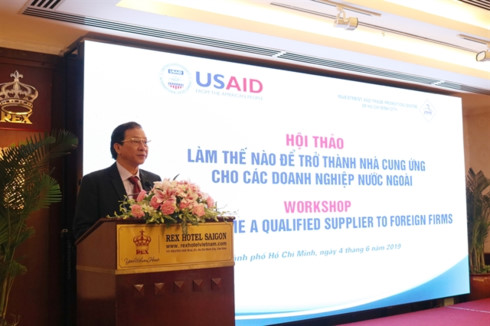Vietnamese SMEs shown how to enter the global supply chain
Wed, 05 Jun 2019 13:42:00 | Print | Email Share:
Vietnam is among the top countries attracting foreign direct investment in the Asia-Pacific region, but the rate of domestic small- and medium-sized enterprises (SMEs) participating in the value chains of foreign-invested companies is rather low, according to the Investment and Trade Promotion Centre of HCM City.

Speaking at the workshop on “How to become a qualified supplier to foreign firms” in HCM City on June 4, ITPC director Pham Thiet Hoa said, “This is a paradox. Currently, SMEs account for 98 per cent of businesses in Vietnam but only 21 per cent of them are linked to foreign supply chains. This rate is lower than in many countries in the Southeast Asian region such as Thailand at 30 per cent and Malaysia at 46 per cent.”
The application of poor technologies, low labour productivity, financial shortcomings, and lack of experience in working with foreign enterprises and high-quality and experienced workers were the main barriers preventing Vietnamese SMEs from entering the global supply chain, he said.
According to experts, manufacturers come to Vietnam for low wages, but productivity in Vietnam is also low at 1/18th of Singapore's, 1/16th of Malaysia's and 1/3rd of Thailand and China's.
Frank Weiand, FF linkage director, USAID LinkSME project in Vietnam, said, “Global firms look for total cost to market.”
Low labour cost is only one factor of production whereas the total cost to market includes all costs including labour, materials, cost of capital (both investment and working capital), transport and logistics, duties, taxes and fees (both formal and informal), and others, according to the director.
“The inadequate local supply chain raises all costs other than labour, and also minimises local labour participation.
“Locating for low labour cost is the wrong reason for Vietnam’s economy – a race to the bottom,” he said.
Domestic enterprises must make efforts to find ways to access and supply raw materials and equipment to foreign-invested firms, according to experts.
They could participate in the global value chain because many foreign investors have invested in the country and the country has free trade agreements with many countries.
The most important thing is that they need to actively seize opportunities.
To deeply participate in the global value chain, Vietnamese enterprises must innovate, analyse their strengths, weaknesses, what buyers need, and ability to supply, among others.
Tran Quang Vu, customer advisory of KPMG Vietnam and Cambodia, spoke about what SMEs should know while working with FDI firms, including how to prepare an effective meeting, how to introduce their businesses professionally and convincingly, principles to build a sustainable customer relationship, and others.
Participants also acquired information about the journey a supplier has to make to become part of an international organisation’s supply chain.
Hoa said the workshop, which sought to share experiences of experts to help local enterprises find solutions to improve their competitiveness and gradually enter the global value chain, was the first in a series of co-operative events between the ITPC and USAID.
By: VNS/VOV
---------------------------------------------
Same category News :













